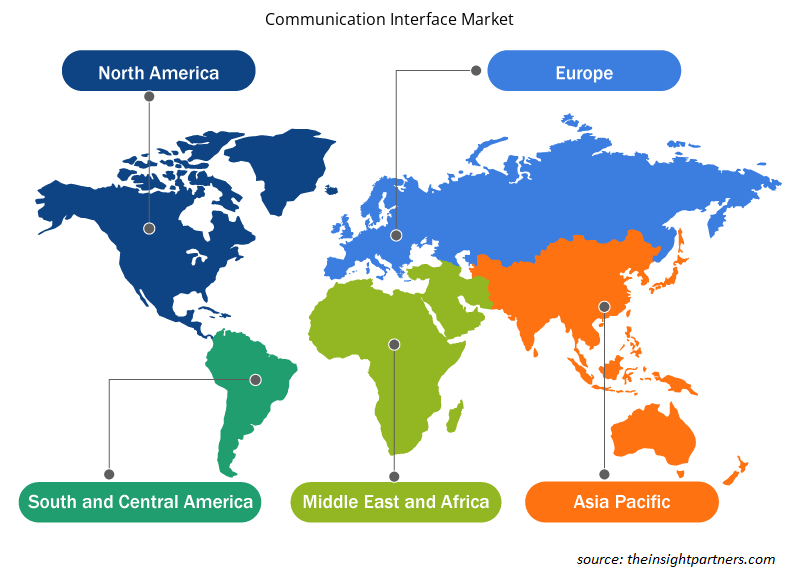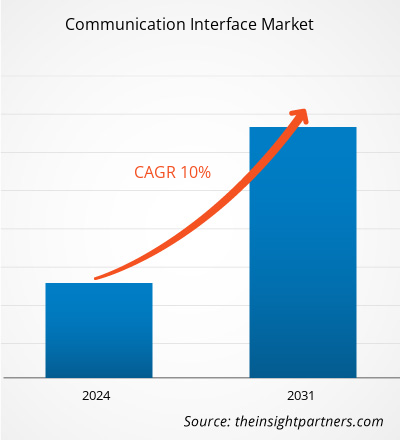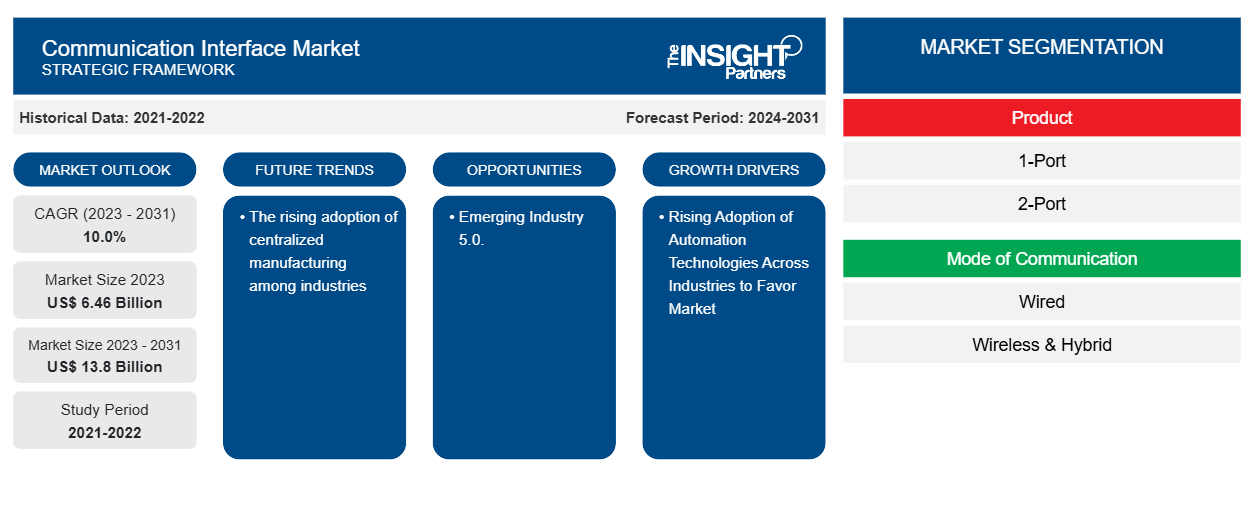Se proyecta que el tamaño del mercado de interfaces de comunicación alcance los 13.800 millones de dólares estadounidenses en 2031, frente a los 6.460 millones de dólares estadounidenses en 2023. Se espera que el mercado registre una CAGR del 10,0 % durante el período 2023-2031. Es probable que la creciente adopción de tecnologías de automatización en todas las industrias y el mayor desarrollo de robots sean los impulsores y las tendencias clave del mercado de interfaces de comunicación.
Análisis del mercado de interfaces de comunicación
El mercado de interfaces de comunicación está experimentando un crecimiento significativo a nivel mundial. Este crecimiento se atribuye a la creciente adopción de tecnologías de automatización en todas las industrias y al mayor desarrollo de robots. Además, se prevé que la aparición de la Industria 5.0 y la creciente adopción de la fabricación centralizada en las industrias impulsen el mercado en los próximos años.
Descripción general del mercado de interfaces de comunicación
Las interfaces de comunicaciones son las interfaces y protocolos que permiten que el software, los sistemas operativos, los directorios, las redes, los sistemas operativos de red o el software basado en web instalados en una computadora interoperen con el software de la plataforma Microsoft en otra computadora, incluidas, entre otras, las comunicaciones diseñadas para garantizar la seguridad, la autenticación o la privacidad.
Personalice este informe según sus necesidades
Obtendrá personalización en cualquier informe, sin cargo, incluidas partes de este informe o análisis a nivel de país, paquete de datos de Excel, así como también grandes ofertas y descuentos para empresas emergentes y universidades.
- Obtenga las principales tendencias clave del mercado de este informe.Esta muestra GRATUITA incluirá análisis de datos, desde tendencias del mercado hasta estimaciones y pronósticos.
Factores impulsores y oportunidades del mercado de las interfaces de comunicación
La creciente adopción de tecnologías de automatización en todas las industrias favorece el mercado
La creciente adopción de tecnologías de automatización en todas las industrias está impulsando el mercado de interfaces de comunicación. Esto se debe a factores como la creciente importancia de la interconectividad. Existe una gran necesidad de una comunicación fluida y conveniente entre varios sistemas y dispositivos en la automatización. La interfaz de comunicación permite la transferencia de datos y la comunicación entre dispositivos. Las interfaces de comunicación comunes incluyen interfaces USB, interfaces HDMI, interfaces VGA, interfaces Ethernet, interfaces de red inalámbrica , etc. Estas interfaces se pueden utilizar para conectar computadoras, dispositivos externos, dispositivos de red, monitores, impresoras, etc., para realizar funciones de transmisión y comunicación de datos. A medida que las industrias amplían sus esfuerzos de automatización, requieren una interfaz de comunicación que pueda adaptarse fácilmente a nuevos requisitos y expansiones.interconnectivity. There is a high need for seamless and convenient communication between various systems and devices in automation. The communication interface enables data transfer and communication between devices. Common communication interfaces include USB interfaces, HDMI interfaces, VGA interfaces, Ethernet interfaces,
Industria emergente 5.0.
El término Industria 5.0 hace referencia a personas que trabajan junto a robots y máquinas inteligentes. Se trata de robots que ayudan a los humanos a trabajar mejor y más rápido aprovechando tecnologías avanzadas como el Internet de las cosas (IoT) y el big data. Añade un toque humano personal a los pilares de la Industria 4.0 de automatización y eficiencia. La Industria 5.0 allana el camino hacia el siguiente ciclo de innovación industrial que se alinea con las plataformas compatibles con la cuarta iteración y aborda la importancia de la colaboración entre la máquina y el hombre, es decir, los robots colaborativos. Las redes de comunicación desempeñan un papel fundamental en el mantenimiento de la integración y la hiperconectividad entre el hombre y las máquinas. Con la evolución de los dispositivos hacia sistemas de sistemas, como la integración del Internet de las cosas (IoT) y los sistemas ciberfísicos (CPS), las características de las redes han sufrido cambios significativos.IoT) and big data. It adds a personal human touch to the Industry 4.0 pillars of automation and efficiency. Industry 5.0 paves the way to the next industrial innovation cycle that aligns with the platforms compatible with the fourth iteration and addresses the importance of collaboration between machine and man, i.e., collaborative robots. Communication networks play a pivotal role in maintaining the integration and hyperconnectivity between man and machines. With the evolution of devices into systems of systems, such as the integration of the Internet of Things (IoT) and cyber-physical systems (CPS), the characteristics of networks have undergone significant changes.
Análisis de segmentación del informe de mercado de interfaz de comunicación
Los segmentos clave que contribuyeron a la derivación del análisis del mercado de la interfaz de comunicación son el producto, el modo de comunicación y la aplicación.
- Según el producto, el mercado de interfaces de comunicación se divide en 1 puerto, 2 puertos y otros. Se prevé que el segmento de 1 puerto tenga una participación de mercado significativa en el período de pronóstico.
- Según el modo de comunicación, el mercado de interfaces de comunicación se divide en cableado (Ethernet, USB, RS-232/RS-485 y otros) e inalámbrico e híbrido. Se prevé que el segmento cableado (Ethernet, USB, RS-232/RS-485 y otros) ocupe una cuota de mercado significativa en el período de pronóstico.ethernet, USB, RS-232/RS-485, and others) and wireless & hybrid. The wired (ethernet, USB, RS-232/RS-485, and others) segment is anticipated to hold a significant market share in the forecast period.
- Por aplicaciones, el mercado está segmentado en monitoreo industrial, sistemas de monitoreo de baterías, comunicación de sensores remotos, sistemas de señalización ferroviaria, comunicación de máquina a máquina y otros. Se prevé que el monitoreo industrial ocupe una participación de mercado significativa en el período de pronóstico.
Análisis de la cuota de mercado de las interfaces de comunicación por geografía
El alcance geográfico del informe de mercado de interfaz de comunicación se divide principalmente en cinco regiones: América del Norte, Asia Pacífico, Europa, Medio Oriente y África, y América del Sur y Central.
América del Norte ha dominado el mercado de interfaces de comunicación. Las tendencias de adopción de alta tecnología en diversas industrias de la región de América del Norte han impulsado el crecimiento del mercado de interfaces de comunicación. Se espera que factores como la mayor adopción de herramientas digitales y el alto gasto tecnológico por parte de las agencias gubernamentales impulsen el crecimiento del mercado de interfaces de comunicación de América del Norte. Además, un fuerte énfasis en la investigación y el desarrollo en las economías desarrolladas de los EE. UU. y Canadá está obligando a los actores norteamericanos a traer soluciones tecnológicamente avanzadas al mercado. Además, Estados Unidos tiene una gran cantidad de actores del mercado de interfaces de comunicación que se han centrado cada vez más en el desarrollo de soluciones innovadoras. Todos estos factores contribuyen al crecimiento del mercado de interfaces de comunicación de la región.fuelled the growth of the communication interface market. Factors such as increased adoption of digital tools and high technological spending by government agencies are expected to drive the North American communication interface market growth. Moreover, a strong emphasis on research and development in the developed economies of the US and Canada is forcing the North American players to bring technologically advanced solutions into the market. In addition, the US has a large number of communication interface market players who have been increasingly focusing on developing innovative solutions. All these factors contribute to the region's growth of the communication interface market.
Perspectivas regionales del mercado de interfaces de comunicación
Los analistas de Insight Partners explicaron en detalle las tendencias y los factores regionales que influyen en el mercado de interfaces de comunicación durante el período de pronóstico. Esta sección también analiza los segmentos y la geografía del mercado de interfaces de comunicación en América del Norte, Europa, Asia Pacífico, Oriente Medio y África, y América del Sur y Central.

- Obtenga datos regionales específicos para el mercado de interfaz de comunicación
Alcance del informe de mercado de interfaces de comunicación
| Atributo del informe | Detalles |
|---|---|
| Tamaño del mercado en 2023 | 6.460 millones de dólares estadounidenses |
| Tamaño del mercado en 2031 | US$ 13.8 mil millones |
| CAGR global (2023 - 2031) | 10,0% |
| Datos históricos | 2021-2022 |
| Período de pronóstico | 2024-2031 |
| Segmentos cubiertos | Por producto
|
| Regiones y países cubiertos | América del norte
|
| Líderes del mercado y perfiles de empresas clave |
|
Densidad de actores del mercado de interfaces de comunicación: comprensión de su impacto en la dinámica empresarial
El mercado de las interfaces de comunicación está creciendo rápidamente, impulsado por la creciente demanda de los usuarios finales debido a factores como la evolución de las preferencias de los consumidores, los avances tecnológicos y una mayor conciencia de los beneficios del producto. A medida que aumenta la demanda, las empresas amplían sus ofertas, innovan para satisfacer las necesidades de los consumidores y aprovechan las tendencias emergentes, lo que impulsa aún más el crecimiento del mercado.
La densidad de actores del mercado se refiere a la distribución de las empresas o firmas que operan dentro de un mercado o industria en particular. Indica cuántos competidores (actores del mercado) están presentes en un espacio de mercado determinado en relación con su tamaño o valor total de mercado.
Las principales empresas que operan en el mercado de interfaces de comunicación son:
- Compañía: ABB Ltd.
- Corporación Eaton Plc
- Honeywell Internacional Inc.
- Corporación Omron
- Automatización Rockwell Inc.
- Sistemas de medición; Inc.
Descargo de responsabilidad : Las empresas enumeradas anteriormente no están clasificadas en ningún orden particular.

- Obtenga una descripción general de los principales actores clave del mercado de interfaces de comunicación
Noticias y desarrollos recientes del mercado de interfaces de comunicación
El mercado de interfaces de comunicación se evalúa mediante la recopilación de datos cualitativos y cuantitativos a partir de investigaciones primarias y secundarias, que incluyen publicaciones corporativas importantes, datos de asociaciones y bases de datos. A continuación, se enumeran algunos de los avances en el mercado de interfaces de comunicación:
- Siemens lanza el módulo de interfaz de comunicación LOGO! Con múltiples protocolos de comunicación, Modbus RTU/TCP, integración de aplicaciones a través de API RESTful y la posibilidad de acceso a la nube, LOGO! CIM es un verdadero punto de inflexión. LOGO! CIM permite enviar y recibir SMS, además de transferir datos desde dispositivos LOGO! 8.3 a la nube de AWS. Con el receptor GNSS (GPS) integrado, se puede rastrear y transmitir la posición. (Fuente: Sitio web de la empresa Siemens, mayo de 2023)
- India lanzó la Interfaz de Pagos Unificada (UPI) en los históricos grandes almacenes de París, Galeries Lafayette, después de un lanzamiento exitoso en la icónica Torre Eiffel. (Comunicado de prensa, julio de 2024)
Informe de mercado de interfaces de comunicación: cobertura y resultados
El informe “Tamaño y pronóstico del mercado de interfaces de comunicación (2021-2031)” proporciona un análisis detallado del mercado que cubre las siguientes áreas:
- Tamaño del mercado de interfaces de comunicación y pronóstico a nivel global, regional y nacional para todos los segmentos clave del mercado cubiertos bajo el alcance
- Tendencias del mercado de interfaces de comunicación, así como dinámicas del mercado, como impulsores, restricciones y oportunidades clave
- Análisis detallado de las cinco fuerzas de Porter y PEST y FODA
- Análisis del mercado de interfaces de comunicación que abarca las tendencias clave del mercado, el marco global y regional, los principales actores, las regulaciones y los desarrollos recientes del mercado
- Análisis del panorama de la industria y la competencia que cubre la concentración del mercado, el análisis de mapas de calor, los actores destacados y los desarrollos recientes para el mercado de interfaces de comunicación.
- Perfiles detallados de empresas
- Análisis histórico (2 años), año base, pronóstico (7 años) con CAGR
- Análisis PEST y FODA
- Tamaño del mercado, valor/volumen: global, regional y nacional
- Industria y panorama competitivo
- Conjunto de datos de Excel
Informes recientes
Testimonios
Razón para comprar
- Toma de decisiones informada
- Comprensión de la dinámica del mercado
- Análisis competitivo
- Información sobre clientes
- Pronósticos del mercado
- Mitigación de riesgos
- Planificación estratégica
- Justificación de la inversión
- Identificación de mercados emergentes
- Mejora de las estrategias de marketing
- Impulso de la eficiencia operativa
- Alineación con las tendencias regulatorias





















 Obtenga una muestra gratuita para - Mercado de interfaces de comunicación
Obtenga una muestra gratuita para - Mercado de interfaces de comunicación